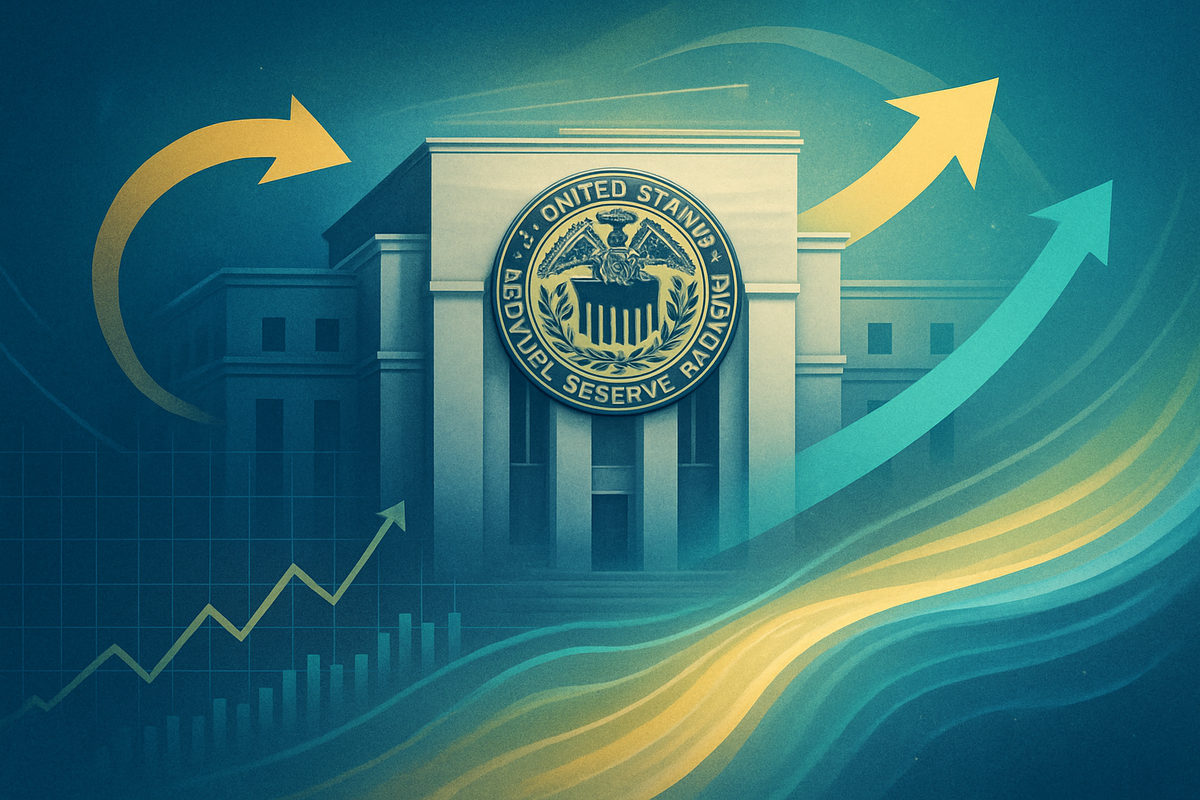
Washington D.C. (October 23, 2025) – The financial world is abuzz with expectations that the Federal Reserve is on the cusp of ending its Quantitative Tightening (QT) program, a move anticipated by leading financial institutions like JPMorgan Chase & Co. (NYSE: JPM) and Bank of America Corp. (NYSE: BAC). This significant pivot in monetary policy, potentially announced as early as the upcoming October 28-29 Federal Open Market Committee (FOMC) meeting, is driven by growing concerns over tightening liquidity in money markets and the Fed's commitment to maintaining financial stability. The immediate implications are largely seen as positive for risk assets, signaling a potential "risk-on" environment across global financial markets.
The cessation of QT is expected to inject much-needed liquidity back into the financial system, easing funding pressures and potentially leading to lower Treasury yields. This shift, coupled with ongoing interest rate cuts—with the federal funds rate already in the 4%-4.25% range and further reductions anticipated—could provide substantial support for equity markets, particularly growth-oriented sectors. However, the move also raises questions about the long-term size of the Fed's balance sheet and the delicate balance between managing inflation and fostering economic growth.
Understanding Quantitative Tightening and the Road to its Conclusion
Quantitative Tightening (QT) is a contractionary monetary policy where a central bank reduces its balance sheet by allowing government bonds and other securities to mature without reinvesting the proceeds, effectively withdrawing money from circulation. This process aims to curb inflation by increasing interest rates and reducing the money supply. Conversely, Quantitative Easing (QE) involves expanding the balance sheet to stimulate the economy.
The Federal Reserve initiated its current QT program in June 2022 to combat surging inflation following the COVID-19 pandemic. Initially, the Fed allowed up to $95 billion in maturing Treasuries and mortgage-backed securities (MBS) to roll off its balance sheet monthly. By October 2025, the Fed has successfully trimmed over $2.2 trillion from its balance sheet, bringing it down from a peak of nearly $9 trillion to approximately $6.6 trillion. This marks a substantial reduction, but the program is now facing calls for its conclusion due to emerging signs of liquidity strain.
Both JPMorgan Chase & Co. (NYSE: JPM) and Bank of America Corp. (NYSE: BAC) have accelerated their forecasts for the end of QT. JPMorgan strategists, led by Teresa Ho, point to "greater frictions" in funding markets and nearly zero balances in the overnight reverse repurchase (ON RRP) facility as key indicators that bank reserves are no longer "ample." Bank of America strategists Mark Cabana and Katie Craig echo this sentiment, stating that current money market rates should signal to the Fed that reserves are no longer "abundant." Federal Reserve Chair Jerome Powell himself has acknowledged that the conclusion of QT "may be coming into view" and that the Fed will halt the runoff when reserve balances are "somewhat above the level we judge consistent with ample reserve conditions" to prevent a repeat of the September 2019 liquidity crunch.
Initial market reactions to these predictions have been largely positive. U.S. equity markets, including the S&P 500 and Nasdaq 100, have shown resilience, buoyed by investor optimism. U.S. Treasury yields have slipped, indicating expectations of lower future interest rates. The U.S. dollar index has weakened, while gold prices have hovered near all-time highs, even surpassing $4,000 and reaching $4,300 per ounce, reflecting reduced opportunity costs for non-yielding assets. The cryptocurrency market, particularly Bitcoin, is also expected to receive a liquidity boost, potentially sparking fresh capital inflows.
Winners and Losers: Corporate Impact of Easing Liquidity
The anticipated end of Quantitative Tightening is poised to create a distinct set of winners and losers across various sectors, driven by changes in market liquidity, interest rates, and investor sentiment. This shift from monetary tightening to a more accommodative stance will fundamentally alter the operating environment for many public companies.
Potential "Winners" are predominantly growth-oriented and capital-intensive businesses. Technology companies and firms involved in AI infrastructure are significant beneficiaries, as lower borrowing costs reduce the expense of financing expansion, research and development, and new projects. Increased liquidity can facilitate strategic capital restructuring and new investments, while lower interest rates make future earnings more valuable, boosting valuations for growth stocks. The Real Estate and Housing sector, often highly leveraged, stands to gain from decreasing financing costs, benefiting real estate investment trusts (REITs) and utilities. Highly leveraged companies across all sectors will see a reduction in interest expenses, improving profitability. Furthermore, assets like gold and cryptocurrencies, including Bitcoin, are expected to thrive due to declining real rates and increased liquidity, potentially seeing significant price appreciation.
Conversely, Potential "Losers" or Challenged Companies include traditional Financial Institutions, particularly banks like Zions Bancorp (NASDAQ: ZION), which might experience pressure on their net interest margins (NIMs) as lower long-term interest rates narrow the spread between lending and deposit rates. While a halt to QT aims to stabilize funding markets, concerns about credit quality, especially among regional banks and in private credit, persist. Banks may also hoard reserves, potentially crimping lending to corporations. Companies with excessively high, unproductive liquidity might see lower profits if they fail to deploy cash effectively. Moreover, if ending QT is perceived as the Fed tolerating a larger balance sheet, it could reignite inflationary pressures. A return to a "higher-for-longer" interest rate sentiment could then rotate capital out of growth-oriented, tech-heavy indices, impacting some of the initial "winners."
Wider Significance: Reshaping Monetary Policy and Market Dynamics
The Federal Reserve's anticipated conclusion of Quantitative Tightening by late 2025 represents more than just a technical adjustment; it signifies a profound recalibration of monetary policy with wide-ranging implications for broader industry trends, financial market participants, and regulatory considerations. This pivot is deeply informed by historical lessons, particularly the 2019 "repo ruckus."
This shift is expected to usher in a period of renewed market liquidity and a "risk-on" sentiment. Coupled with ongoing interest rate cuts, this could trigger substantial upward movements in stocks and other risk assets, including cryptocurrencies. In the Treasury market, halting QT would reduce the supply of government bonds that the private sector needs to absorb, potentially easing pressure and leading to lower yields. However, sustained high fiscal spending could still push longer-term yields higher. The move also impacts global currency stability, with a pause in balance sheet normalization potentially influencing the U.S. dollar.
Ripple effects will be felt across the financial ecosystem. Banks and financial institutions are expected to be primary beneficiaries as funding markets stabilize and liquidity constraints ease, reducing short-term rate volatility. Corporations, particularly growth-oriented and capital-intensive businesses in sectors like technology and AI infrastructure, will benefit from renewed liquidity and potentially lower borrowing costs. Internationally, the Fed's pivot has global ramifications, influencing capital flows and potentially leading to divergent capital movements, especially in emerging markets.
From a regulatory and policy perspective, the end of QT underscores a fundamental shift towards a more neutral or accommodative monetary policy, prioritizing the maintenance of "ample reserves" as a core objective. The Fed's balance sheet is expected to remain significantly larger than pre-2008 levels, with an ongoing discussion about shifting its composition towards a higher share of Treasury securities and a gradual decline in MBS over the long term. This suggests a potential "soft QT" where the balance sheet's ratio to GDP declines as the economy grows. The interaction with fiscal policy, such as debt ceiling negotiations, also plays a crucial role in influencing bank liquidity.
The most salient historical precedent is the liquidity crunch and spike in overnight lending rates in September 2019. During that period, the Fed's earlier QT efforts (2017-2019) had reduced bank reserves to insufficient levels, forcing the Fed to intervene and prematurely end QT. This episode profoundly impacted market awareness of liquidity scarcity and is a primary reason the Fed is keen to stop the current QT "somewhat above" what it considers ample reserves, aiming to prevent a repeat. This QT cycle, however, has been faster and under different economic conditions, including higher initial inflation, emphasizing that QT's effects vary significantly depending on the prevailing environment.
What Comes Next: Navigating a New Monetary Landscape
The conclusion of the Federal Reserve's Quantitative Tightening program by late 2025 marks a critical juncture, setting the stage for significant short-term and long-term possibilities that will reshape financial markets and strategic corporate adaptations.
In the short term, the immediate aftermath is expected to be characterized by enhanced market liquidity and a pronounced "risk-on" sentiment. This could fuel further rallies in equity markets, particularly benefiting growth-oriented companies and firms in AI infrastructure, as borrowing costs potentially decrease due to ongoing interest rate cuts. Treasury yields are likely to face downward pressure, while the U.S. dollar may depreciate, supporting assets like gold, which could rise towards $4,700/oz, and cryptocurrencies. However, challenges persist; if the halt to QT signals underlying economic weakness, equity markets might face turbulence. Moreover, if the larger balance sheet is perceived as accommodating increased fiscal spending, it could reignite inflationary pressures, potentially leading to a "higher-for-longer" interest rate environment for some long-term yields.
Looking to the long term, the end of QT signals a structural shift in the Fed's approach. The Fed's balance sheet is expected to remain permanently larger than its pre-pandemic size, operating under an "ample reserves regime" where administered rates will be the primary tool for influencing interest rates. The desired composition of the balance sheet will likely shift towards Treasury securities, with MBS gradually declining. Even after the formal end of QT, a "soft form of QT" might occur as the ratio of the Fed's total assets to GDP declines with economic growth. Persistent inflation concerns, with core inflation still above the Fed's 2% target, remain a key challenge, especially if the larger balance sheet is seen as inflationary. The Fed will continue to utilize tools like the Standing Repo Facility (SRF) to manage liquidity and prevent future market disruptions. Strategic pivots for corporations will involve adapting to potentially lower, but still volatile, interest rate environments, optimizing capital structures, and seeking opportunities in growth sectors benefiting from increased liquidity.
Comprehensive Wrap-up: A New Chapter for Monetary Policy
The Federal Reserve's imminent halt to its Quantitative Tightening program represents a landmark decision, concluding a critical phase of post-pandemic monetary policy and ushering in a new chapter for global financial markets. This strategic pivot, driven by a desire to ensure ample banking system reserves and prevent liquidity crises, underscores the Fed's evolving approach to managing the economy.
The key takeaway is a fundamental shift towards a more accommodative monetary posture. The Fed has learned from past liquidity crunches, notably the 2019 "repo ruckus," and is prioritizing financial stability by ensuring sufficient reserves. The balance sheet, having shed over $2.2 trillion, is not expected to return to pre-pandemic levels, signaling a permanently larger footprint for the central bank in the financial system.
Assessing the market moving forward, a "risk-on" environment is largely anticipated, fueled by renewed liquidity and expected interest rate cuts. Equities, particularly growth-oriented sectors and AI infrastructure firms, are poised for potential rallies. Gold and cryptocurrencies are also expected to benefit from declining real rates. However, challenges remain, including the persistent threat of inflation, which is still above the Fed's target, and the delicate balance of ensuring evenly distributed liquidity across the banking system. Credit quality concerns, especially in regional banks and private credit, also warrant close monitoring.
The significance and lasting impact of this move are profound. It solidifies the Fed's commitment to an "ample reserves" operating framework, where administered rates are the primary policy tool. It also highlights the complex interplay between monetary and fiscal policy, especially given ongoing government debt issuance. This dovish pivot by the Fed could also encourage other major central banks to pursue similar easing measures, potentially leading to a synchronized global monetary easing cycle.
For investors in the coming months, vigilance is paramount. Closely monitor official Fed communications, FOMC minutes, and speeches from Fed officials for any signals regarding the "ample reserves" level or future balance sheet adjustments. Re-evaluate asset allocations, considering increased exposure to equities in growth sectors and diversifying with assets like gold. Pay close attention to inflation data and money market liquidity indicators to gauge the health of the financial system and anticipate potential policy shifts. Understanding the Fed's "ample reserves" regime will be crucial for navigating this evolving landscape.
This content is intended for informational purposes only and is not financial advice






